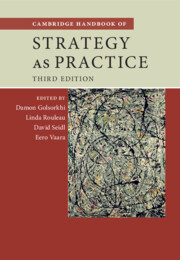Book contents
- Cambridge Handbook of Strategy as Practice
- Cambridge Handbook of Strategy as Practice
- Copyright page
- Contents
- Figures
- Tables
- Boxes
- Contributors
- Preface to the Third Edition
- Introduction: What Is Strategy as Practice?
- Part I Ontological and Epistemological Questions
- Part II Theoretical Resources: Social Theory
- Part III Theoretical Resources: Organization and Management Theories
- Chapter 17 An Institutional Perspective on Strategy as Practice
- Chapter 18 Identity Work as a Strategic Practice
- Chapter 19 Sensemaking in Strategy as Practice: From a Phenomenon towards a Theory?
- Chapter 20 Routine Dynamics and Connections to Strategy as Practice
- Chapter 21 The Communicative Constitution of Strategy-Making: Exploring Fleeting Moments of Strategy
- Chapter 22 A Social-Symbolic Work Perspective on Strategy as Practice: The Objects of Strategy Work
- Chapter 23 Relating Strategy as Practice to the Resource-Based View, Capabilities Perspectives and Micro-Foundations Approaches
- Chapter 24 Analytical Frames for Studying Power in Strategy as Practice and Beyond
- Chapter 25 Strategy as Practice and the Critical Eye
- Part IV Methodological Resources
- Part V Substantive Topic Areas
- Index
- References
Chapter 25 - Strategy as Practice and the Critical Eye
from Part III - Theoretical Resources: Organization and Management Theories
Published online by Cambridge University Press: 11 March 2025
- Cambridge Handbook of Strategy as Practice
- Cambridge Handbook of Strategy as Practice
- Copyright page
- Contents
- Figures
- Tables
- Boxes
- Contributors
- Preface to the Third Edition
- Introduction: What Is Strategy as Practice?
- Part I Ontological and Epistemological Questions
- Part II Theoretical Resources: Social Theory
- Part III Theoretical Resources: Organization and Management Theories
- Chapter 17 An Institutional Perspective on Strategy as Practice
- Chapter 18 Identity Work as a Strategic Practice
- Chapter 19 Sensemaking in Strategy as Practice: From a Phenomenon towards a Theory?
- Chapter 20 Routine Dynamics and Connections to Strategy as Practice
- Chapter 21 The Communicative Constitution of Strategy-Making: Exploring Fleeting Moments of Strategy
- Chapter 22 A Social-Symbolic Work Perspective on Strategy as Practice: The Objects of Strategy Work
- Chapter 23 Relating Strategy as Practice to the Resource-Based View, Capabilities Perspectives and Micro-Foundations Approaches
- Chapter 24 Analytical Frames for Studying Power in Strategy as Practice and Beyond
- Chapter 25 Strategy as Practice and the Critical Eye
- Part IV Methodological Resources
- Part V Substantive Topic Areas
- Index
- References
Summary
Martin Blom and Mats Alvesson highlight the value of strategy as practice scholars adopting a ‘critical eye’ on their research. The authors review and comment on strategy as practice from a critical perspective and suggest how a critical perspective can be leveraged in a future research agenda. For this purpose, they outline five critical management studies oriented themes for future strategy as practice research, partly based on previous studies with a ‘critical touch’, but also adding some new, and perhaps more radical questions and contributions in relation to previous strategy as practice literature.
- Type
- Chapter
- Information
- Cambridge Handbook of Strategy as Practice , pp. 453 - 474Publisher: Cambridge University PressPrint publication year: 2025

